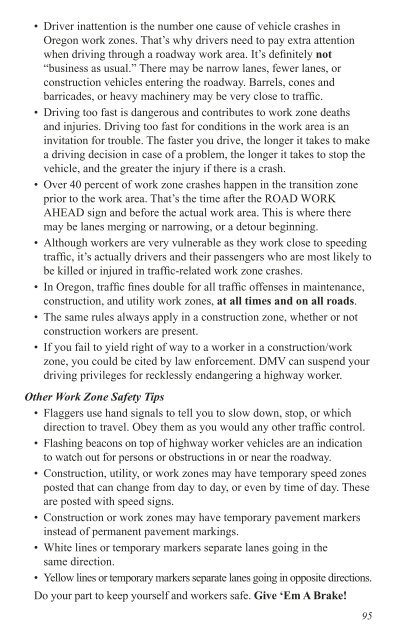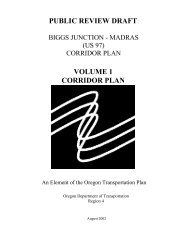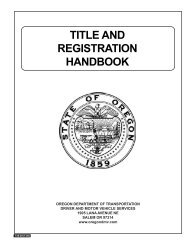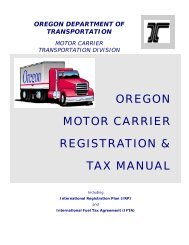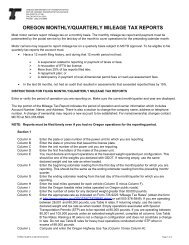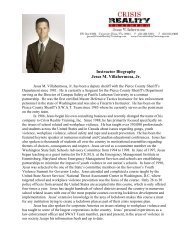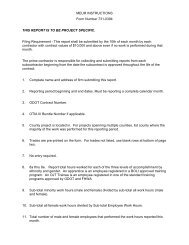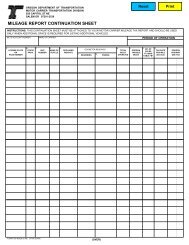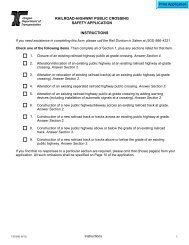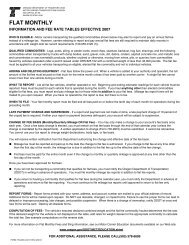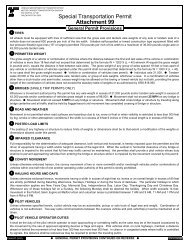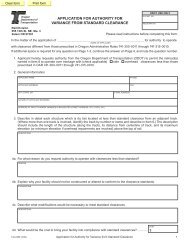2013 Oregon Driver Manual - Oregon Department of Transportation
2013 Oregon Driver Manual - Oregon Department of Transportation
2013 Oregon Driver Manual - Oregon Department of Transportation
Create successful ePaper yourself
Turn your PDF publications into a flip-book with our unique Google optimized e-Paper software.
• <strong>Driver</strong> inattention is the number one cause <strong>of</strong> vehicle crashes in<br />
<strong>Oregon</strong> work zones. That’s why drivers need to pay extra attention<br />
when driving through a roadway work area. It’s defi nitely not<br />
“business as usual.” There may be narrow lanes, fewer lanes, or<br />
construction vehicles entering the roadway. Barrels, cones and<br />
barricades, or heavy machinery may be very close to traffi c.<br />
• Driving too fast is dangerous and contributes to work zone deaths<br />
and injuries. Driving too fast for conditions in the work area is an<br />
invitation for trouble. The faster you drive, the longer it takes to make<br />
a driving decision in case <strong>of</strong> a problem, the longer it takes to stop the<br />
vehicle, and the greater the injury if there is a crash.<br />
• Over 40 percent <strong>of</strong> work zone crashes happen in the transition zone<br />
prior to the work area. That’s the time after the ROAD WORK<br />
AHEAD sign and before the actual work area. This is where there<br />
may be lanes merging or narrowing, or a detour beginning.<br />
• Although workers are very vulnerable as they work close to speeding<br />
traffi c, it’s actually drivers and their passengers who are most likely to<br />
be killed or injured in traffi c-related work zone crashes.<br />
• In <strong>Oregon</strong>, traffi c fi nes double for all traffi c <strong>of</strong>fenses in maintenance,<br />
construction, and utility work zones, at all times and on all roads.<br />
• The same rules always apply in a construction zone, whether or not<br />
construction workers are present.<br />
• If you fail to yield right <strong>of</strong> way to a worker in a construction/work<br />
zone, you could be cited by law enforcement. DMV can suspend your<br />
driving privileges for recklessly endangering a highway worker.<br />
Other Work Zone Safety Tips<br />
• Flaggers use hand signals to tell you to slow down, stop, or which<br />
direction to travel. Obey them as you would any other traffi c control.<br />
• Flashing beacons on top <strong>of</strong> highway worker vehicles are an indication<br />
to watch out for persons or obstructions in or near the roadway.<br />
• Construction, utility, or work zones may have temporary speed zones<br />
posted that can change from day to day, or even by time <strong>of</strong> day. These<br />
are posted with speed signs.<br />
• Construction or work zones may have temporary pavement markers<br />
instead <strong>of</strong> permanent pavement markings.<br />
• White lines or temporary markers separate lanes going in the<br />
same direction.<br />
• Yellow lines or temporary markers separate lanes going in opposite directions.<br />
Do your part to keep yourself and workers safe. Give ‘Em A Brake!<br />
95


